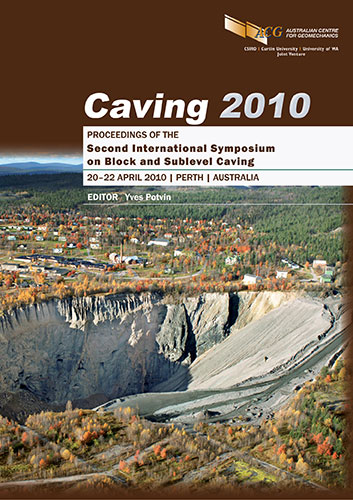Multi-scale simulation of ground support designs for extreme tunnel closure

|
Authors: Beck, DA; Kassbohm, S; Putzar, G |
DOI https://doi.org/10.36487/ACG_rep/1002_30_Beck
Cite As:
Beck, DA, Kassbohm, S & Putzar, G 2010, 'Multi-scale simulation of ground support designs for extreme tunnel closure', in Y Potvin (ed.), Caving 2010: Proceedings of the Second International Symposium on Block and Sublevel Caving, Australian Centre for Geomechanics, Perth, pp. 441-453, https://doi.org/10.36487/ACG_rep/1002_30_Beck
Abstract:
The numerical simulation of ground support requires that the ground deformation and support response are both captured accurately. The mechanisms of rock mass damage, dilation and deterioration must first be simulated sufficiently to produce realistic tunnel deformation in 3D, then the physical response of the support elements must be realistic if the support and loading systems will come to a realistic equilibrium. This requires the simulation of rock mass and mechanical behaviour on a number of different length scales and demands a level of similitude that is not commonly implemented for mine models. The load-displacement response of both the support and the rock mass around excavations must be correct for the models to be valid. A multi-scale approach to mine deformation modelling can be used to improve the similitude of capacity and demand simulation of ground support. Case studies are used to demonstrate the behaviour of several heavy support systems using this approach. Some proposed support designs for a deep cave subject to high stress and expected significant drive closure are tested and the limitations and vulnerabilities of the support systems are exposed. The modelling methods used to simulate the mine deformation, drive behaviour and support system response are discussed and some sufficiency requirements for similar analysis are highlighted.
References:
Beck, D.A. (2008) Multi-scale, non-linear numerical analysis of mining induced deformation, in Proceedings 42nd US Rock Mechanics Symposium and 2nd US -Canada Rock Mechanics Symposium, held in San Francisco, June 29 – July 2, 2008, ARMA, American Rock Mechanics Association.
Beck, D.A. and Reusch, F. (2009) A numerical investigation of scale effects on the behaviour of discontinuous rock, in Proceedings 43rd US Rock Mechanics Symposium held in Asheville, 2008, ARMA, American Rock Mechanics Association.
Davis, E.H. (1968) Theories of plasticity and the failure of soil masses, in Soil Mechanics: Selected Topics, Butterworths, London.
Drucker, D.C., Prager, W. and Greenberg, H.J. (1952) Extended limit design theorems for continuous media, Quarterly of Applied Mathematics, Vol. 9, pp. 381–389.
Hill, R. (1951) On the state of stress in a plastic-rigid body at the yield point, Philosophical Magazine, Vol. 42,
pp. 868–875.
Hodge, P.G. (1958) The mathematical theory of plasticity, in Elasticity and plasticity, John Wiley and Sons, New York.
Lubliner, J. (1990) Plasticity Theory, Macmillan Publishing Company, New York.
© Copyright 2025, Australian Centre for Geomechanics (ACG), The University of Western Australia. All rights reserved.
View copyright/legal information
Please direct any queries or error reports to repository-acg@uwa.edu.au
View copyright/legal information
Please direct any queries or error reports to repository-acg@uwa.edu.au